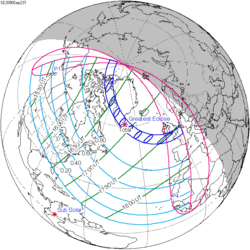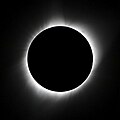Solar eclipses of 1924–1928
This eclipse is a member of a semester series. An eclipse in a semester series of solar eclipses repeats approximately every 177 days and 4 hours (a semester) at alternating nodes of the Moon's orbit. [3]
The partial solar eclipses on March 5, 1924 and August 30, 1924 occur in the previous lunar year eclipse set, and the solar eclipses on May 19, 1928 and November 12, 1928 occur in the next lunar year eclipse set.
| Solar eclipse series sets from 1924 to 1928 |
|---|
| Ascending node | | Descending node |
|---|
| Saros | Map | Gamma | Saros | Map | Gamma |
|---|
| 115 | July 31, 1924

Partial | −1.4459 | 120 | January 24, 1925

Total | 0.8661 |
| 125 | July 20, 1925

Annular | −0.7193 | 130

Totality in Sumatra, Indonesia | January 14, 1926

Total | 0.1973 |
| 135 | July 9, 1926

Annular | 0.0538 | 140 | January 3, 1927

Annular | −0.4956 |
| 145 | June 29, 1927

Total | 0.8163 | 150 | December 24, 1927

Partial | −1.2416 |
| 155 | June 17, 1928

Partial | 1.5107 |
Saros 155
This eclipse is a part of Saros series 155, repeating every 18 years, 11 days, and containing 71 events. The series started with a partial solar eclipse on June 17, 1928. It contains total eclipses from September 12, 2072 through August 30, 2649; hybrid eclipses from September 10, 2667 through October 2, 2703; and annular eclipses from October 13, 2721 through May 8, 3064. The series ends at member 71 as a partial eclipse on July 24, 3190. Its eclipses are tabulated in three columns; every third eclipse in the same column is one exeligmos apart, so they all cast shadows over approximately the same parts of the Earth.
The longest duration of totality will be produced by member 14 at 4 minutes, 5 seconds on November 6, 2162, and the longest duration of annularity will be produced by member 63 at 5 minutes, 31 seconds on April 28, 3046. All eclipses in this series occur at the Moon’s ascending node of orbit. [4]
| Series members 1–16 occur between 1928 and 2200: |
|---|
| 1 | 2 | 3 |
|---|

June 17, 1928 | 
June 29, 1946 | 
July 9, 1964 |
| 4 | 5 | 6 |
|---|

July 20, 1982 | 
July 31, 2000 | 
August 11, 2018 |
| 7 | 8 | 9 |
|---|

August 21, 2036 | 
September 2, 2054 | 
September 12, 2072 |
| 10 | 11 | 12 |
|---|

September 23, 2090 | 
October 5, 2108 | 
October 16, 2126 |
| 13 | 14 | 15 |
|---|

October 26, 2144 | 
November 7, 2162 | 
November 17, 2180 |
| 16 |
|---|

November 28, 2198 |
Metonic series
The metonic series repeats eclipses every 19 years (6939.69 days), lasting about 5 cycles. Eclipses occur in nearly the same calendar date. In addition, the octon subseries repeats 1/5 of that or every 3.8 years (1387.94 days). All eclipses in this table occur at the Moon's ascending node.
| 25 eclipse events between April 5, 1837 and June 17, 1928 |
|---|
| April 5–6 | January 22–23 | November 10–11 | August 28–30 | June 17–18 |
|---|
| 107 | 109 | 111 | 113 | 115 |
|---|

April 5, 1837 | 
January 22, 1841 | 
November 10, 1844 | 
August 28, 1848 | 
June 17, 1852 |
| 117 | 119 | 121 | 123 | 125 |
|---|

April 5, 1856 | 
January 23, 1860 | 
November 11, 1863 | 
August 29, 1867 | 
June 18, 1871 |
| 127 | 129 | 131 | 133 | 135 |
|---|

April 6, 1875 | 
January 22, 1879 | 
November 10, 1882 | 
August 29, 1886 | 
June 17, 1890 |
| 137 | 139 | 141 | 143 | 145 |
|---|

April 6, 1894 | 
January 22, 1898 | 
November 11, 1901 | 
August 30, 1905 | 
June 17, 1909 |
| 147 | 149 | 151 | 153 | 155 |
|---|

April 6, 1913 | 
January 23, 1917 | 
November 10, 1920 | 
August 30, 1924 | 
June 17, 1928 |
Tritos series
This eclipse is a part of a tritos cycle, repeating at alternating nodes every 135 synodic months (≈ 3986.63 days, or 11 years minus 1 month). Their appearance and longitude are irregular due to a lack of synchronization with the anomalistic month (period of perigee), but groupings of 3 tritos cycles (≈ 33 years minus 3 months) come close (≈ 434.044 anomalistic months), so eclipses are similar in these groupings.
| Series members between 1801 and 1928 |
|---|

May 25, 1808
(Saros 144) | 
April 24, 1819
(Saros 145) | 
March 24, 1830
(Saros 146) | 
February 21, 1841
(Saros 147) | 
January 21, 1852
(Saros 148) |

December 21, 1862
(Saros 149) | 
November 20, 1873
(Saros 150) | 
October 19, 1884
(Saros 151) | 
September 18, 1895
(Saros 152) | 
August 20, 1906
(Saros 153) |

July 19, 1917
(Saros 154) | 
June 17, 1928
(Saros 155) |
Inex series
This eclipse is a part of the long period inex cycle, repeating at alternating nodes, every 358 synodic months (≈ 10,571.95 days, or 29 years minus 20 days). Their appearance and longitude are irregular due to a lack of synchronization with the anomalistic month (period of perigee). However, groupings of 3 inex cycles (≈ 87 years minus 2 months) comes close (≈ 1,151.02 anomalistic months), so eclipses are similar in these groupings.
The partial solar eclipse on December 18, 2188 (part of Saros 164) is also a part of this series but is not included in the table below.
| Series members between 1801 and 1928 |
|---|

September 5, 1812
(Saros 151) | 
August 16, 1841
(Saros 152) | 
July 28, 1870
(Saros 153) |
| 
June 17, 1928
(Saros 155) | |
This page is based on this
Wikipedia article Text is available under the
CC BY-SA 4.0 license; additional terms may apply.
Images, videos and audio are available under their respective licenses.




































































